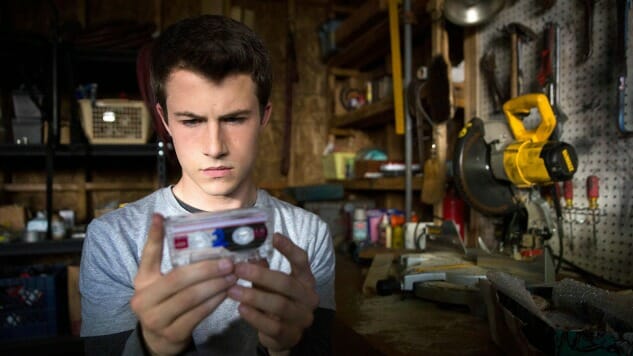Introducing Endless Mode: A New Games & Anime Site from Paste
You might have noticed that there’s a new(ish) binge-watch in town—Netflix’s moving young-adult drama 13 Reasons Why. The show, adapted from Jay Asher’s novel of the same name, explores the life and subsequent suicide of high school student Hannah Baker (Katherine Langford), who leaves behind a series of cassette tapes that outline the reasons why she took her life. One day, the tapes end up in the possession of sweet everyguy Clay Jensen (Dylan Minnette), who had a giant crush on Hannah and may or may not have had something to do with her death.
Part of the show’s appeal, aside from the strong acting and unblinking portrayal of how bitterly nasty high school can be, is its soundtrack, complete with melancholic John Hughes-era throwbacks (“Fascination Street” by The Cure, “The Killing Moon” by Echo and the Bunnymen, “Love Will Tear Us Apart” by Joy Division) and like-minded contemporaries (M83, Chromatics, The Japanese House). Most of the 20th century song selections appear to play up adolescent moodiness, something to which 13 Reasons Why music supervisor Season Kent (The Spectacular Now, Suicide Squad, The Fault in Our Stars) can attest. “There was so much emotion and different things happening with all of the kids,” she tells Paste over the phone. “And the tone was really important to [creator] Brian Yorkey. He had to make sure each scene was playing the right way. The story is unfolding as you watch each of these episodes. You know [Hannah] killed herself, but we don’t know how or who — it’s such a mystery. Some [songs] had to have mystery elements; some had to have dark, gothic elements. In that it’s a very dark show. And lonely. I think a lot of it’s very isolating. A lot of these kids are experiencing that, not just Hannah.”
Indeed, one of the most solitary scenes features Clay coming to terms with his role in Hannah’s death. The character, who until recently we’ve come to know as a deer-in-headlights awkward sort of kid, is at home taking a shower. Suddenly, he breaks down and begins to sob uncontrollably. The scene is set to Elliott Smith rendition of “Thirteen”—a song Kent reveals almost didn’t make the cut. “The song kind of says it all,” she says. “It is that song for the scene. Elliott Smith still speaks to so many people, especially teenagers. I think for boys, too…All of our editors, who are all men, all were really drawn to that song. I think he just speaks to adolescence in a real way.”
Kent also admits that the show was lucky to have even been permitted to use Smith’s track at all. “His estate, which I think is his mom, signs off on his publishing,” she explains. “Because the show is about suicide, we weren’t sure if they were going to allow us to use it. I had Brian write a letter to them about the show explaining what it is and the awareness of suicide. It’s so beyond what happened to Hannah. It’s so much deeper than that.”
Equally moving is a scene featuring a contribution from pastoral-folk luminaries Lord Huron.
The episode revisits the moment in which Clay and Hannah slow-dance at the winter formal, playing out differently according to what he wishes would have happened (that he’d been suave enough to spin her around on the dance floor and kiss her) and what actually happened (she abruptly pulls away to deal with a cruel rumor gone awry). Haunted by what could have been, Clay’s mind yanks him away from the tender image of the two dancing and instead shows him a bleeding Hannah on the gymnasium floor as the school watches a basketball game. Lord Huron’s “The Night We Met” (which is now at No. 1 on their Spotify page with more than 20,000,000 streams) soundtracks. “It was a song that felt like it would play at a dance,” Kent says. “Initially we had the thought of Mazzy Star, or something like that, but then we went more contemporary. It needed to have dual meaning. And that song was really interesting because in the beginning of the episode, it’s very sweet. Clay wants to get a copy of the song, and then it turns really dark when he’s having his hallucination, when he sees her during the basketball game and there’s blood all over her. I love how that song has this arc in the episode. It’s very sweet, and then it’s very haunting.”
As successful as 13 Reasons Why has been (according to Fizziology, a research firm that analyzes social-media data, there were more tweets about 13 Reasons Why the week after its premiere than there were about any other Netflix show), its graphic suicide scene depicting Hannah slitting her wrists in a bathtub has stirred up controversy, with mental-health professionals, including the American Foundation for Suicide Prevention accusing the show of glamorizing suicide. Like Yorkey, Kent firmly stands behind the scene in question. “They wanted as real as possible,” she says. “From what Brian told me, it was really important to him — he wanted kids to really see it. I feel like if you didn’t go there, [audiences] would be like, ‘Why didn’t you go there?’ I’ve worked on so many [shows and movies] about teens and high school — the thing I loved so much about this is that it was really real. This is how high school kids act. This is how they talk. This is what they’re doing to each other. How mean they are. This is the music they’re listening to. All those things. I applaud [the show] for going there.”
